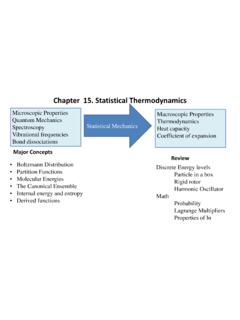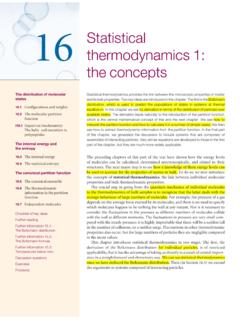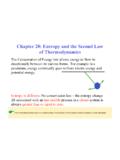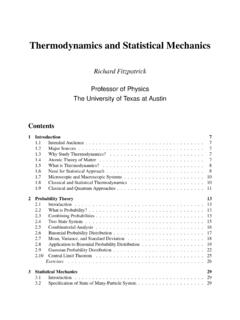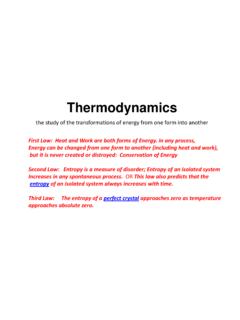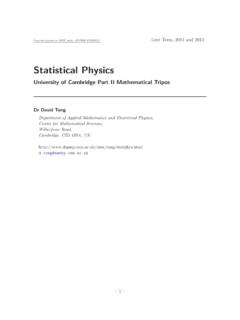Transcription of A Crash Course in Statistical Mechanics - Harvard University
1 A Crash Course in Statistical MechanicsNoah MillerDecember 27, 2018 AbstractA friendly introduction to Statistical Mechanics , geared towardscovering the powerful methods physicists have developed for workingin the Statistical Entropy .. Temperature and Equilibrium .. The Partition Function .. Free energy .. Phase Transitions .. Example: Box of Gas .. Shannon Entropy .. Quantum Mechanics , Density Matrices .. Example: Two state system .. Entropy of Mixed States .. Classicality from environmental entanglement .. The Quantum Partition Function .. 271 Statistical EntropyStatistical Mechanics is a branch of physics that pervades all otherbranches. Statistical Mechanics is relevant to Newtonian Mechanics ,relativity, quantum Mechanics , and quantum field 1: Statistical Mechanics applies to all realms of exact incarnation is a little different in each quadrant, but thebasic details are most important quantity in Statistical Mechanics is called en-tropy, which we label byS.
2 People sometimes say that entropy is ameasure of the disorder of a system, but I don t think this a good wayto think about it. But before we define entropy, we need to discuss twodifferent notions of state: microstates and macrostates. In physics, we like to describe the real world as mathematical classical physics, states are points in a phase space. Say for exampleyou hadNparticles moving around in 3 dimensions. It would take6 Nreal numbers to specify the physical state of this system at a giveninstant: 3 numbers for each particle s position and 3 numbers for eachparticle s momentum. The phase space for this system would thereforejust beR6N.(x1,y1,z1,px1,py1,pz1,..xN,yN,zN,p xN,pyN,pzN) R6N(In quantum Mechanics , states are vectors in a Hilbert spaceHinsteadof points in a phase space. We ll return to the quantum case a bit later.)
3 A microstate is a state of the above form. It contains absolutelyall the physical information that an omniscent observer could know. Ifyou were to know the exact microstate of a system and knew all of thelaws of physics, you could in principle deduce what the microstate willbe at all future times and what the microstate was at all past , practically speaking, we can never know the true microstateof a system. For example, you could never know the positions and mo-menta of every damn particle in a box of gas. The only things we canactually measure are macroscopic variables such as internal energy, vol-ume, and particle number(U,V,N). A macrostate is just a set of2microstates. For examples, the macrostate of a box of gas labelled by(U,V,N)would be the set of all microstates with energyU, volumeV,and particle numberN.
4 The idea is that if you know what macrostateyour system is in, you know that your system is equally likely to trulybe in any of the microstates it 2: You may know the macrostate, but only God knows the am now ready to define what entropy is. Entropy is a quantity asso-ciated with a macrostate. If a macrostate is just a set of microstates,then the entropySof the system isS klog .(1)Here,kis Boltzmann s constant. It is a physical constant with units ofenergy / 10 23 JoulesKelvin(2)3 The only reason that we needkto defineSis because the human racedefined units of temperature before they defined entropy. (We ll seehow temperature factors into any of this soon.) Otherwise, we probablywould have setk= 1and temperature would have the same units might be wondering how we actually count . As you probablynoticed, the phase spaceR6 Nis not discrete.
5 In that situation, weintegrate over a phase space volume with the , this isn t completely satisfactory because position and mo-mentum are dimensionful quantities while should be a dimensionlessnumber. We should therefore divide by a constant with units of posi-tion times momentum. Notice, however, that becauseSonly dependsonlog , any constant rescaling of will only alterSby a constant andwill therefore never affect the change in entropy Sof some process. Sowhile we have to divide by a constant, whichever constant we divide bydoesn t affect the , even though we are free to choose whatever dimensionfulconstant we want, the best is actually Planck s constanth! Therefore,for a classical macrostate that occupies a phase space volumeVol, =1N!1h3N VolN i=1d3xid3pi.(3)(The prefactor1/N!is necessary if allNparticles are is the cause of some philosophical consternation but I don t want toget into any of that.)
6 Let me now explain why I think saying entropy is disorder is notsuch a good idea. Different observers might describe reality with differ-ent macrostates. For example, say your room is very messy and disor-ganized. This isn t a problem for you, because you spend a lot of timein there and know where everything is. Therefore, the macrostate youuse to describe your room contains very few microstates and has a smallentropy. However, according to your mother who has not studied yourroom very carefully, the entropy of your room is very large. The pointis that while everyone might agree your room is messy, the entropy ofyour room really depends on how little you know about Temperature and EquilibriumLet s say we label our macrostates by their total internal energyUand some other macroscopic variables likeVandN. (Obviously,these other macroscopic variablesVandNcan be replaced by differentquantities in different situations, but let s just stick with this for now.)
7 Our entropySdepends on all of these (U,V,N)(4)The temperatureTof the(U,V,N)macrostate is then be defined to be1T S U V,N.(5)The partial derivative above means that we just differentiateS(U,V,N)with respect toUwhile your system has a high temperature and you add a bit of energydUto it, then the entropySwill not change much. If your system has asmall temperature and you add a bit of energy, the entropy will increasea , say you have two systemsAandBwhich are free to tradeenergy back and 3: Two systemsAandBtrading +UBis systemAcould be in one of Apossible microstates and systemBcould be in Bpossible microstates. Therefore, the totalABsystemcould be in A Bpossible microstates. Therefore, the entropySABofboth systems combined is just the sum of entropies of both ( A B) =klog A+klog B=SA+SB(6)5 The crucial realization of Statistical Mechanics is that, all else beingequal, a system is most likely to find itself in a macrostate correspondingto the largest number of microstates.
8 This is the so-called Second lawof thermodynamics : for all practical intents and purposes, the entropyof a closed system always increases over time. It is not really a physical law in the regular sense, it is more like a profound , the entropySABof our jointABsystem will increase astime goes on until it reaches its maximum possible value. In other words,AandBtrade energy in a seemingly random fashion that increasesSABon average. WhenSABis finally maximized, we say that our systemsare in thermal equilibrium. Figure 4:SABis maximized whenUAhas some particular value.(It should be noted that there will actually be tiny random "thermal"fluctuations around this maximum.)Let s say that the internal energy of systemAisUAand the internalenergy of systemBisUB. Crucially, note that the total energy ofcombined systemUAB=UA+UBis constant over time!
9 This is because energy of the total system isconserved. Therefore,dUA= , the combined system will maximize its entropy whenUAandUBhave some particular values. Knowing the value ofUAis enough though,becauseUB=UAB UA. Therefore, entropy is maximized when0 = SAB UA.(7)6 However, we can rewrite this as0 = SAB UA= SA UA+ SB UA= SA UA SB UB=1TA , our two systems are in equilibrium if they have the sametemperature!TA=TB(8)If there are other macroscopic variables we are using to define ourmacrostates, like volumeVor particle numberN, then there will beother quantities that must be equal in equibrium, assuming our two sys-tems compete for volume or trade particles back and forth. In thesecases, we define the quantitiesPand to bePT S V U,N T S N U,V.(9)Pis called pressure and is called chemical potential.
10 In equilib-rium, we would also havePA=PB A= B.(10)(You might object that pressure has another definition, namely force di-vided by area. It would be incumbent on us to check that this definitionmatches that definition in the relevant situation where both definitionshave meaning. Thankfully it does.) The Partition FunctionFigure 5: If you want to do Statistical Mechanics , you really shouldknow about the partition calculating for a given macrostate is usually very speaking, it can only be done for simple systems you under-stand very well. However, physicists have developed an extremely pow-erful way of doing Statistical Mechanics even for complicated turns out that there is a function of temperature called the partitionfunction that contains all the information you d care to know aboutyour macrostate when you are working in the thermodynamic limit.










